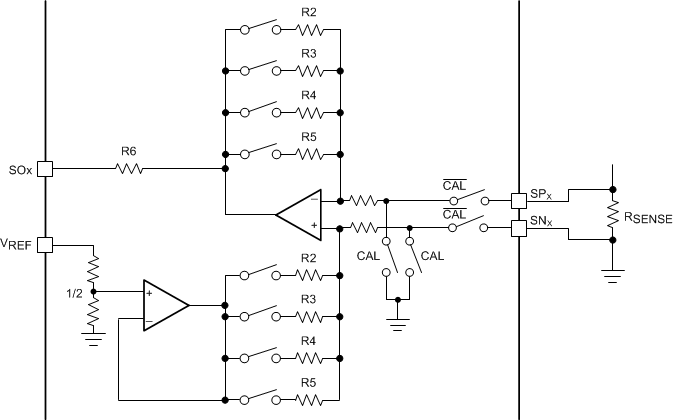JAJSFH4B November 2017 – July 2018 DRV8304
UNLESS OTHERWISE NOTED, this document contains PRODUCTION DATA.
- 1 特長
- 2 アプリケーション
- 3 概要
- 4 改訂履歴
- 5 Pin Configuration and Functions
- 6 Specifications
-
7 Detailed Description
- 7.1 Overview
- 7.2 Functional Block Diagram
- 7.3
Feature Description
- 7.3.1 3-Phase Smart Gate Drivers
- 7.3.2 DVDD Linear Voltage Regulator
- 7.3.3 Pin Diagrams
- 7.3.4 Low-Side Current-Shunt Amplifiers
- 7.3.5 Gate-Driver Protection Circuits
- 7.4 Device Functional Modes
- 7.5 Programming
- 7.6
Register Maps
- Table 1. DRV8304S Register Map
- 7.6.1 Status Registers (DRV8304S Only)
- 7.6.2
Control Registers (DRV8304S Only)
- 7.6.2.1 Driver Control Register (Address = 0x02) [reset = 0x00]
- 7.6.2.2 Gate Drive HS Register (Address = 0x03) [reset = 0x377]
- 7.6.2.3 Gate Drive LS Register (Address = 0x04) [reset = 0x777]
- 7.6.2.4 OCP Control Register (Address = 0x05) [reset = 0x145]
- 7.6.2.5 CSA Control Register (Address = 0x06) [reset = 0x283]
- 8 Application and Implementation
- 9 Power Supply Recommendations
- 10Layout
- 11デバイスおよびドキュメントのサポート
- 12メカニカル、パッケージ、および注文情報
パッケージ・オプション
デバイスごとのパッケージ図は、PDF版データシートをご参照ください。
メカニカル・データ(パッケージ|ピン)
- RHA|40
サーマルパッド・メカニカル・データ
- RHA|40
発注情報
7.3.4.3 Offset Calibration
The DRV8304 device provides an auto calibration feature to minimize the amplifier input offset on power up or during an ENABLE reset pulse to account for temperature and device variation. Auto calibration is performed on both the hardware and SPI device options. The auto calibration begins immediately after the VREF pin crosses the minimum operational VREF voltage and completes in several µs (max 500 µs). During auto calibration, the inputs to the amplifier are disconnected from SPX and SNX pin and shorted internally. After auto calibration the amplifiers are ready for operation.
For the SPI device option, auto calibration can also be performed during run time by setting the AUTOCAL bit. If the AUTOCAL bit is already set once, then the user must reset the bit and again set it to perform the auto-calibration. The user must wait for at least 500 µs before another write to ensure a successful calibration. The user is recommended not to sample CSA outputs during the AUTOCAL operation.
In addition to this, the device also supports an external calibration through the SPI registers (SPI_CAL) in SPI device or through CAL pin in hardware device variant. When the calibration is enabled (CAL pin or SPI_CAL), the inputs to the amplifier are shorted internally, and the amplifier voltage can be observed though SOX pin for doing the external calibration. For the best results, perform offset calibration when the external MOSFETS are not switching to reduce the potential noise impact to the amplifier. DC calibration can be done at any time, even when the half-bridges are operating. Figure 36 shows a diagram of the calibration mode
 Figure 36. Amplifier Calibration Mode
Figure 36. Amplifier Calibration Mode